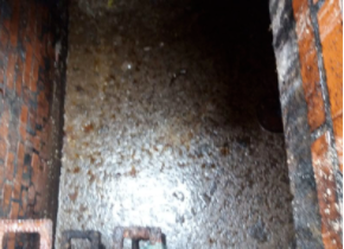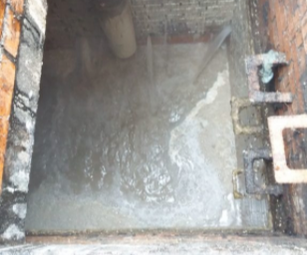controlling fat, oil and grease
FOG is a pollution prevention term for fats, oils, and grease. Restaurants and other food service establishments (FSEs) use FOG in their kitchens and improper management of FOG can lead to costly and unpleasant sewer blockages. FOG is a combination of fats, oils, and grease used in food processing and the preparation of meals. FOG bearing materials include:
- Cooking oil
- Fat
- Lard
- Grease
- Butter
- Tallow
- Shortening
- Margarine
- Meat
- Sauces
- Cookies and pastries
|
Why is FOG a problem?
Waste FOG accumulates in the sewer system causing obstruction or blockage of the sewer pipe, ultimately resulting in a sewer overflow. FOG also accumulates in pump station wet wells and primary settling tanks causing a decrease in capacities and an increase in maintenance requirements. |
|
Types of FOG
Tallow or oil used in deep fryers is known as Yellow grease. It can be recycled and reused for a variety of purposes. “Grease recyclers” (also known as “grease renderers”) will come to your location and collect this by product for later use in products such as soaps, cosmetics, and biodiesel fuels. On the other hand, any FOG that is in your plumbing system is known as Brown grease. It needs to be removed so that it doesn’t clog the system. “Brown grease hauliers” come collect the brown grease from traps and interceptors and dispose of it properly. |
Controlling FOG
When it comes to controlling FOG, Grease traps and grease interceptors help keep FOG out of your pipes, the city sewers, and the environment beyond, but they don’t clean themselves. Grease traps are kept indoors and usually maintained by restaurant employees. Grease interceptors are found outdoors and are typically cleaned by professional services. Even when using an outside company to service the traps, it’s important to make sure the job is done correctly.
The biggest contributor to sewer back-ups is improper maintenance. All the sinks, dishwashers, and floor drains are connected by the same piping, so neglecting just one element can still affect the whole system. Traps and interceptors need to be cleaned regularly. Floor drains should be cleaned at least once a year. If you forget, the foul odours seeping through your floors and vents will surely remind you.
When it comes to controlling FOG, Grease traps and grease interceptors help keep FOG out of your pipes, the city sewers, and the environment beyond, but they don’t clean themselves. Grease traps are kept indoors and usually maintained by restaurant employees. Grease interceptors are found outdoors and are typically cleaned by professional services. Even when using an outside company to service the traps, it’s important to make sure the job is done correctly.
The biggest contributor to sewer back-ups is improper maintenance. All the sinks, dishwashers, and floor drains are connected by the same piping, so neglecting just one element can still affect the whole system. Traps and interceptors need to be cleaned regularly. Floor drains should be cleaned at least once a year. If you forget, the foul odours seeping through your floors and vents will surely remind you.
What you can do?
Scrape and wipe down pots, pans, and work areas prior to washing.
Dispose of food waste directly into the compost bin or trash.
Do not pour waste oil directly into the drain, parking lot, or street.
Do not use emulsifiers or solvents other than dishwashing detergents.
The process of Bio-augmentation is the act of adding additional bacteria to a given application in order to increase the biological activity in that process.
Scrape and wipe down pots, pans, and work areas prior to washing.
Dispose of food waste directly into the compost bin or trash.
Do not pour waste oil directly into the drain, parking lot, or street.
Do not use emulsifiers or solvents other than dishwashing detergents.
The process of Bio-augmentation is the act of adding additional bacteria to a given application in order to increase the biological activity in that process.
|
The GPC Clear Solutions bio-augmentation system is designed specifically for two applications simultaneously.
Continuous forward feed operation that produces product over a 24-hour cycle, allowing continuous re-seeding of the required plant. Fat breaks down by: Bacteria > Enzymes > glycerol/fatty acids > CO2 and water The process has four different types of bacteria for the specific application.
|



